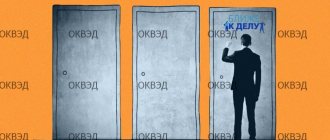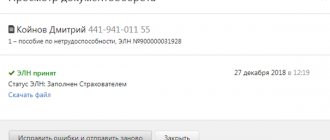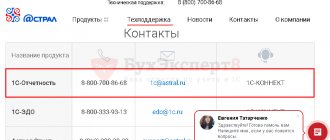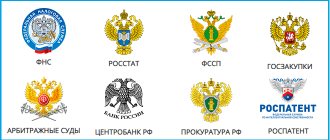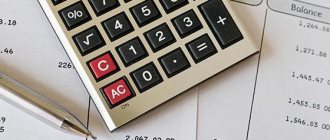Starting from the first quarter of 2015, taxpayers submit VAT returns using a new form (Order of the Ministry of Finance of Russia dated October 29, 2014 No. ММВ-7-3 / [email protected] ). Now the company reports to the tax authorities information from the purchase book and sales book and information about issued invoices (sections 8–12 of the declaration).
The tax authorities have at their disposal a special automated control system for VAT-2 (hereinafter referred to as ASK VAT-2). This system stores and accumulates all information on taxpayer transactions. Let's consider what claims tax authorities make based on the results of the analysis of the ASK VAT-2 database.
Can ASK VAT-2 affect special regime officers?
Undoubtedly! The use of a special regime does not mean that you will not become a potential “victim”. And in the most unexpected way.
Don’t forget that since 2018, some special regime employees at the Unified Agricultural Tax have received the right to voluntarily pay VAT, and large agricultural producers have been forced to pay VAT (Federal Law of November 27, 2017 N 335-FZ).
All this means that at any time you can move from the category of “untouchable” to VAT payers. Each submitted declaration is a mandatory control in the ASK VAT-2 system! Therefore, you need to know how it works and how to protect yourself from unfounded attacks by inspectors.
How does ASK VAT-2 work?
- You submit a VAT return.
- The system independently analyzes data for each operation along the chain of movement of goods and identifies tax gaps in transactions for which there is a deduction, but VAT has not been paid.
- Unscrupulous VAT payers are automatically detected, and a tree of connections with other participants in the trade turnover is built.
- The totality of the data obtained allows tax authorities to identify the beneficiary of VAT tax deductions. It can be absolutely any organization or individual entrepreneur claiming a tax deduction ─ after all, the right to deductions is given to those who buy goods (works or services) from their counterparties who present the amount of tax (clause 2 of Article 171 of the Tax Code of the Russian Federation).
This is when your counterparty:
- Or submitted a zero VAT return.
- Or he didn’t pass it at all.
- Or you submitted the declaration, but did not reflect the invoice issued to you in the sales book (or distorted the data).
Thus, often all the headaches from ASK VAT-2 are caused by erroneous actions/inactions of our counterparties or the existence of relationships they have with shell companies.
If contradictions are identified in the VAT declaration, the system automatically generates a requirement to provide explanations (Letter of the Federal Tax Service of the Russian Federation dated November 6, 2015 N ED-4-15/19395). And then, other tax control measures are just around the corner.
Keep in mind that the powers of tax inspectors when conducting desk audits have expanded significantly today. Let's say a tax gap has been identified. To identify the recipient of an unjustified tax benefit, inspectors can use an expanded list of tax control measures already within the chamber: requesting a voluminous list of documents, inspecting premises and territories, interviewing employees.
Well, you don’t need to explain to anyone that the camera will provoke an unscheduled on-site inspection - such prospects are unlikely to make anyone happy.
How to protect yourself from combining ASK VAT-2 with the customs service base? Interview on Business FM
The automatic report data of this program can initiate a criminal case (if the amount of violations exceeds the amount established by law).
Lately, tax officials have gotten the hang of sending information to the Department of Economic Crimes immediately after a camera meeting ─ we are gradually being accustomed to the idea that conducting any tax audit automatically means an inspection by the security forces and criminal prosecution. Moreover, it will not be possible to accuse the tax authorities of illegal actions (Article 4 of the “Agreement on interaction between the Ministry of Internal Affairs of the Russian Federation and the Federal Tax Service” dated October 13, 2010 N ММВ-27-4/11, Letter of the Federal Tax Service of the Russian Federation dated April 22, 2015 N PA-4-6/6929 ).
The number of tax audits initiated thanks to the VAT-2 ASK is growing and, as judicial practice shows, most of these audits resulted in a victory for the tax authorities in the form of additional assessments or denials of deductions.
Don't want to become another "victim"?
More details about the event program can be found here
Please confirm your participation by registering using the link
How to automate accounting in trade
To ensure the transparency of your business for tax authorities, use accounting automation solutions (for example, 1C or Kontur). If you have a product accounting program connected, you can set up data exchange. For example, the LiteBox commodity accounting service integrates with 1C and the Kontur.Elba program via file exchange or via API.
Data exchange allows you to simplify the work of an accountant: synchronize reference books of items and counterparties, transactions with accounts. Reports in the accounting program are generated based on commodity accounting data. For example, after acceptance of goods, unloading in 1C occurs in the context of item, quantity, and name of supplier. Further postings are carried out in 1C in the required unified form.
Automation of accounting and commodity accounting helps the accountant quickly obtain data on inventory balances, cash flow and suppliers, and upload data into Excel. As a result, maintaining accounting records becomes more convenient and simpler, and the risk of errors and tax audits is reduced.
ASK VAT-2: where should taxpayers expect threats?
Starting from the first quarter of 2015, taxpayers submit VAT returns using a new form (Order of the Ministry of Finance of Russia dated October 29, 2014 No. ММВ-7-3 / [email protected] ). Now the company reports to the tax authorities information from the purchase book and sales book and information about issued invoices (sections 8–12 of the declaration).
The tax authorities have at their disposal a special automated control system for VAT-2 (hereinafter referred to as ASK VAT-2). This system stores and accumulates all information on taxpayer transactions. Let's consider what claims tax authorities make based on the results of the analysis of the ASK VAT-2 database.
How is the amount of VAT that is subject to reimbursement (refund) to the taxpayer from the budget formed?
The peculiarity of VAT is that, at the end of the quarter, the taxpayer determines the difference between the tax received from buyers (i.e., calculated on taxable transactions) and the tax transferred to its suppliers (tax deduction for VAT).
If the amount of VAT tax deductions exceeds the total amount of tax calculated for taxable transactions, then the resulting difference is subject to reimbursement (refund) to the taxpayer from the budget after a desk tax audit of the VAT return filed by him.
The system identifies discrepancies in declarations
ASK VAT-2 allows tax authorities to compare information from purchase books and sales books along the chain from the supplier to the final buyer. The program verifies counterparties, invoices and tax amounts indicated on them. The system can detect several types of discrepancies.
Discrepancies of the type “VAT”. The program identifies these discrepancies when the tax is indicated in the declarations, but there are errors in them. The list of such errors is known to many accountants. These are discrepancies in the transaction code, incorrect invoice number or date, as well as discrepancies in the amount of VAT payable by the seller and deductible by the buyer.
Some accountants agree with the requirements of inspectors and submit updated declarations. However, if there are technical errors that do not affect the amount of tax, it is sufficient to provide an explanation. They must be accompanied by invoices and other documents. In this case, providing clarification is the right, and not the obligation of the taxpayer (paragraph 2, paragraph 1, article 81 of the Tax Code of the Russian Federation). This includes typos in invoice numbers and dates and incorrect transaction codes. If the company does not match the amount of VAT declared for deduction on the invoice from the supplier, then the most common case is the presentation of VAT for deduction in a later period. For example, the supplier reflected the invoice in the first quarter of 2021, and the buyer accepted VAT for deduction in the second quarter of 2016.
Discrepancies of the “gap” type. We are talking about the so-called tax gap. When comparing data from the purchase and sales books, it turns out that the counterparty whose invoice is stated in the declaration is simply not in the Unified State Register of Legal Entities.
Either he does not submit tax reports, or he submits them with zero indicators. With this type of gap, the taxpayer receives an invoice, the amount of tax for which is not reflected in the counterparty’s declaration. If the company is a supplier and VAT is declared for payment, then, most likely, this will not cause suspicion, since VAT has been paid to the budget. But if the company is a buyer and has declared this VAT deductible, then the inspectorate will most likely immediately formulate a requirement to submit documents (clause 8.1 of Article 88 of the Tax Code of the Russian Federation).
However, if the company has submitted the entire package of documents, then it is not yet possible to refuse deductions based on discrepancies identified according to the AKS VAT-2 data. A sign of a deduction is the presence of an invoice (Article 169 of the Tax Code of the Russian Federation). And if the inspectors intend to refuse deductions, then they are obliged to carry out tax control measures. These measures must prove the fictitiousness of one-day transactions or the presence of other unjustified tax benefits.
In judicial practice, there are interesting cases of losses for tax authorities when they refused to allow companies to make deductions on invoices of counterparties that were not included in the Unified State Register of Legal Entities. In one of the cases, the accountant of a company expelled from the Unified State Register of Legal Entities continued to issue invoices for two years on behalf of a non-existent company (decision of the Moscow City Court of June 20, 2013 No. A40-18764/13).
The tax authority denied deductions. The company redid the invoices and submitted them to the court. The arbitrators indicated that the organization did not suspect that the invoices were invalid and could not verify this fact. The court canceled the additional assessments. At the same time, the company could check the status of the counterparty using publicly available services on the website of the Federal Tax Service of Russia. Therefore, such court decisions are rather isolated and cannot be relied upon.
Taxpayers are faced with a tax gap when ASK VAT-2 cannot compare invoices for advances issued and when offsetting these advances. This is due to the fact that the company that paid the counterparty an advance prepares the invoice itself. Even if you have the correct transaction code, ASK VAT-2 often generates a requirement indicating the absence of a “twin” invoice. In this case, it is enough to provide written explanations and attach documents to them.
The purpose of introducing ASK VAT-2 is to combat fly-by-night scams
ASK VAT-2 helps tax authorities identify an unscrupulous link in the trade chain - a fly-by-night. The stage at which the tax has not reached the budget. This is necessary to find the ultimate beneficiary who receives unjustified benefits from tax gaps. The risk management system “SUR ASK NDS-2” is responsible for searching for beneficiaries. Its main tasks are described in the letter of the Federal Tax Service of Russia dated 06/03/16 No. ED-4-15 / [email protected] “On the assessment of RMS risk indicators.” Taxpayers may fall into low, medium and high risk groups. Companies with low tax risk have material and labor resources, conduct real activities, and pay taxes. They have on-site inspections.
Organizations with persistent signs of ephemeral activity are classified as high-risk. They have no assets or personnel, pay little taxes with high turnover, and use third parties to make payments. Inspectors mark the company's risk group in the program using color indicators. Tax authorities use the results of “SUR ASK VAT-2” when deciding on VAT refunds and planning on-site audits.
For the effective use of ASK VAT-2, inspectors received expanded powers at their desks. They use almost the same list of control measures as during on-site inspections. Inspectors may require the company to provide:
- documents due to discrepancies in transactions (clause 8.1 of Article 88, Article 93 of the Tax Code of the Russian Federation, Appendix No. 15 to the order of the Federal Tax Service of Russia dated 05/08/15 No. ММВ-7-2 / [email protected] );
- explanations (clause 3 of Article 88 of the Tax Code of the Russian Federation, Appendix No. 1 to the order of the Federal Tax Service of Russia dated 05/08/15 No. ММВ-7-2/ [email protected] ).
If the organization has received a request, it is necessary to send a receipt of receipt of the electronic document via telecommunication channels within six working days. Otherwise, the inspectorate may block bank accounts (subclause 1.1, clause 3, article 76 of the Tax Code of the Russian Federation).
Taxpayers send a response to the request for the submission of documents to the inspectorate within 10 working days from the date of receipt of the request (clause 8.1 of Article 88, Article 93 of the Tax Code of the Russian Federation). And written explanations - within five working days (clause 3 of article 88 of the Tax Code of the Russian Federation).
Companies rarely ignore document submission requirements. This is fraught with a fine (Article 126 of the Tax Code of the Russian Federation) and denial of deductions on formal grounds.
It is better to provide explanations too. Otherwise, the inspector will draw up a desk inspection report (clause 5 of Article 88 of the Tax Code of the Russian Federation). Then you will have to recoup additional charges by filing objections or in court.
However, confirmation of the right to deduction during a camera meeting does not guarantee that the company will not be assigned an on-site inspection (Article 89 of the Tax Code of the Russian Federation). The duration of a desk inspection is limited to three months, so inspectors often do not have time to collect evidence that can stand up in court. The courts believe that inspectors have the right to order an on-site inspection of a period that has already been inspected off-site. Taxpayers are not exempt from liability for detected offenses (Resolution of the Federal Antimonopoly Service of the West Siberian District dated June 24, 2011 No. A75-8783/2010).
Tax officials can also schedule an on-site audit after tax control activities, which will be carried out by the pre-audit analysis department. The maximum period for an on-site inspection is 15 months. Subject to extension (up to six months) and suspension (six or nine months). In such an impressive period of time, inspectors will definitely collect the necessary evidence.
Judicial practice on ASK VAT-2 has not yet been formed
The argument about “tax gaps” in the ASK VAT-2 database is new for judicial practice. So far it is rare. There are several reasons for this.
Firstly, ASK VAT-2 is an internal database of the tax authorities; there is no public access to it. The courts do not recognize information from internal information resources as proper evidence (resolution of the Moscow District Court of December 28, 2015 No. F05-18124/2015). The company may learn about the fiscal conclusions made on the basis of internal information no earlier than negative tax consequences occur.
Second, the tax gap itself does not prove that the tax benefit is unreasonable. This gap is only a mathematical result of the control ratios of the numbers in the two declarations. If the numbers are different, this is just a reason to check.
Nevertheless, information from the ASK VAT-2 has already begun to appear in judicial practice. And not only in disputes related to VAT deductions.
For example, in the resolution of the Volga Region Autonomous District Court dated June 24, 2016 No. Ф06-9933/2016, the company challenged the tax authority’s refusal to register the liquidation of a legal entity in the Unified State Register of Legal Entities*. The company compiled a liquidation balance sheet and submitted it to the inspectorate. However, the inspection, based on the results of two chamber VAT declarations, denied the company deductions for an impressive amount and handed over inspection reports.
* Read more about this in the article “Tax officials refused to liquidate a company with an unreliable balance sheet” on the website e.nalogplan.ru or in “PNP” No. 9, 2021, p. 82.
After the cameral decisions come into force, the tax authority could post the VAT debt on a personal account and become a creditor of the company. In addition, at the time of filing the liquidation application, the company had not submitted another VAT return. As a result, the inspectorate recognized the company's balance sheet as unreliable and refused state registration of the changes. In the decision of the appellate instance, the judges indicated that the tax authority, with the help of the VAT-2 ASK, established the existence of a tax gap in the form of an unlawfully declared VAT deduction (Resolution of the Twelfth AAS dated April 15, 2016 No. 12AP-2681/2016).
The tax authorities issued demands for the presentation of documents. The company ignored the demands and did not provide documents. The head of the company also avoided appearing for questioning.
The company believed that at the time of filing the liquidation balance sheet, the tax authority did not have a decision on desk audits. Therefore, the amount of VAT payable was unknown to him. However, the court took into account the fact of opposition and evasion of society from submitting documents. And I came to the conclusion that the application for liquidation was filed to avoid additional charges due to inspections.
The court decided that the company knowingly provided false information, and the liquidation procedure cannot be considered complied with. The legality of additional accruals based on desk audits was not the subject of the dispute. Therefore, regarding the unreliability of the balance sheet, the court supported the inspection.
The unusual case was considered by the Nineteenth AAS (resolution dated 08/31/16 No. A14-16854/2015). The evidence found in the ASC VAT-2 was stated by one of the parties in a civil dispute. It was between two legal entities regarding the falsification of the manager’s signature in an agreement.
The company went to court with a demand to collect from the counterparty the debt under the supply agreement for 12 tons of fishmeal. However, the buyer unexpectedly declared in court that the manager’s signature on the contract was fake. This means that the deal was not concluded and there are no grounds for compensating the seller for losses.
As evidence of the reality of the shipment, the supplier presented a contract, an invoice for goods acceptance, emails to the buyer and replies to them. In addition, the seller submitted a letter from the inspectorate stating that, based on the results of desk audits of the declarations of both companies, the tax authority found an invoice for the supply of fishmeal in both the seller’s declaration and the buyer’s declaration. The tax authorities found the invoice by cross-comparing declarations in the ASK VAT-2 system.
The tax authorities confirmed that the buyer claimed a deduction due to the fact that the seller reflected the transaction in the declaration and paid VAT on it to the budget.
Complex tax gaps for VAT and in-depth desk audit
If a gap occurs based on the results of processing the auto-requests sent by the system, the problem is not eliminated, then so-called “complex discrepancies” arise. That is, the system establishes that at the place of the gap on the part of the buyer and the seller there are transitors - otherwise “technical . Complex discrepancies established by the VAT ASK system are centrally sent by the Interregional Inspectorate for Desk Control to the inspectorate where the gap arose in order to identify beneficiary organizations/beneficiaries in the formal supply chain.
When conducting an in-depth desk audit, the tax authorities determine who, if a gap occurs in the supply chain, is the transitor and who is the beneficiary, taking into account the information:
- about the leader and founders, including the definition of the attribute “mass leader/founder”;
- about the average number of employees;
- about the upcoming exclusion of the organization from the Unified State Register of Legal Entities as an inactive legal entity;
- about the presence in the Unified State Register of Legal Entities of information about the unreliability of information about the director, founder, and registration address;
- on the availability and content of interrogation protocols of managers and founders;
- about disqualified persons;
- on the availability of current accounts and their number, information on the suspension of transactions on bank accounts;
- about the addresses of registration (registration), registration at the place of “mass registration”;
- about the assets of the organization and whether a declaration on the property tax of organizations is provided;
- about the tax burden and the share of tax deductions;
- about the date of registration (age of organizations);
- on comparison of the tax base in declarations and the turnover of funds in current accounts;
- about the presence of arrears in taxes and obligatory payments;
- about turnover on the current account of organizations and purpose, the presence of operations characteristic of real organizations;
- on methods of submitting declarations, information about digital signature;
- and so on. depending on the depth of control.
ASK NDS-2
ASK VAT-2 has been operating for three years. It stores information from invoices, VAT returns, and transaction information. The system collects data on VAT payment throughout the entire trade chain: from the primary supplier to the final consumer.
The system is operated by data processing centers (DPCs) in Nizhny Novgorod and the Moscow region. In 2017–2020, the authorities plan to build a backup data center in the Volgograd region.
Data centers allow the Federal Tax Service of Russia to implement other administration tools. This includes tax monitoring, a system for monitoring the use of cash register equipment (ASK KKT), and electronic services. They also support the operation of information systems of the Ministry of Finance, the Federal Tax Service, the Treasury and other institutions of the financial department.
11/14/2016. Article topic:
Reference
Abbreviation PC ASK NDS-2
stands for “software package for automated control over value added tax, second version.”
At the end 2013
, the Federal Tax Service launched the ASK VAT-1 PC for the first time.
From this moment on, the Federal Tax Service takes control of data on transactions subject to VAT. A year later, the Federal Tax Service reported a double reduction in illegal attempts to refund taxes, which added 102 billion to the budget. rubles At the beginning 2015
, the Federal Tax Service launched the second version of the ASK VAT-2 program. The work of the ASK VAT-2 program is aimed at identifying organizations that do not pay VAT and do not reflect the corresponding tax charges in the tax return.
Risk-based approach to controlling VAT refunds
All VAT returns that claim reimbursement from the value added tax budget are automatically assigned their own risk level: high, medium or low:
- high level of risk – taxpayers in whose work there have been recorded violations, the level of fulfillment of their tax obligations is low, and therefore the likelihood of on-site inspections is especially high.
- medium risk level – this group includes taxpayers who partially fail to fulfill their tax obligations;
- low level of risk of tax offenses – taxpayers fulfilling their obligations to accrue and pay taxes.
Declarations assigned a high and medium tax risk receive “special attention” from the tax office, which conducts a desk tax audit.
The introduction of a new automated risk-based approach to monitoring VAT refunds using the ASK VAT system was one of the factors that made it possible to achieve an increase in VAT revenues.
ASK VAT-2: find out about your potential VAT risks and ways to reduce them!
All information is accumulated in the Big data
, which is used to process data from PC ASK NDS-2.
Thus, all VAT reports (and therefore all invoices) now fall into the all-Russian database (data center of the Federal Tax Service of Russia in Dubna). The program is aimed at comparing data on each operation along the goods movement chain. Big Data
is a system for processing huge amounts of data, formed in the late 2000s, as an alternative to the traditional database management system (DBMS).
Defining Characteristics of Big Data:
- data volume,
- data processing speed,
- variety of simultaneous processing of various types of data.
Since 2013, big data as an academic subject has been studied in emerging university programs in data science, computational science and engineering.
Algorithm of operation of ASK VAT-2
- The program compares the VAT charged by the seller (according to his sales book) and the VAT accepted for deduction by the buyer (according to his purchase book).
- If these data do not match, the program finds out what is wrong: whether the seller reflected the sale and how lawfully the buyer declared tax deductions.
- Everything happens without the participation of an inspector: the tax office automatically sends requests for explanations to the buyer and seller.
- You have five days to respond, and then the local inspectorate begins an inspection.
- As a result, taxpayers either correct payment errors themselves or receive notification of additional assessments.
Scheme of operation of ASK NDS-2
RESULT:
By introducing the PC ASK VAT-2, tax officials actually automated the classic “counter check”, for greater efficiency, also introducing the necessary amendments to the Tax Code, which began to work from the beginning of 2015. The use of new Big Data technologies makes it possible to automatically compare the data of counterparties, quickly identify and suppress the illegal activities of fraudulent companies that do not fulfill their tax obligations. Now the Federal Tax Service, having identified inconsistencies in the reporting of the buyer and seller, can request invoices and primary documentation from companies. And a company that has not confirmed receipt of tax demands or notifications may have its accounts blocked by tax authorities.
How tax authorities and ASK VAT-2 work
- You submit a VAT return.
- The system independently analyzes data for each operation along the chain of movement of goods and identifies tax gaps in transactions for which there is a deduction, but VAT has not been paid.
- Unscrupulous VAT payers are automatically detected, and a tree of connections with other participants in the trade turnover is built.
- The totality of the data obtained allows tax authorities to identify the beneficiary of VAT tax deductions. It can be absolutely any organization or individual entrepreneur claiming a tax deduction - after all, the right to deductions is given to those who buy goods (work or services) from their counterparties who present the tax amount (clause 2 of Article 171 of the Tax Code of the Russian Federation).
What does "tax gap" mean?
This is when your counterparty:
- Or submitted a zero VAT return.
- Or he didn’t pass it at all.
- Or you submitted the declaration, but did not reflect the invoice issued to you in the sales book (or distorted the data).
Thus, often all the headaches from ASK VAT-2 are caused by erroneous actions/inactions of our counterparties or the existence of relationships they have with shell companies.
- If contradictions are identified in the VAT declaration, the system automatically generates a request for explanations.
- This is followed by other tax control measures. Let's say a tax gap has been identified. To identify the recipient of an unjustified tax benefit, inspectors can use an expanded list of tax control measures already within the chamber: requesting a voluminous list of documents, inspecting premises, territories, interviewing employees, etc. ...
- Conscientious taxpayers are also under attack. Most audits after identifying tax gaps end unfavorably. Claims from inspectors regarding violations of third parties can be made specifically against bona fide companies and, more likely, against those who have property. Even in cases where you yourself interact with a bona fide counterparty, but there are “gray” or “black” companies in the chain.
- The number of tax audits initiated thanks to the VAT-2 ASK is growing and, as judicial practice shows, most of these audits resulted in a victory for the tax authorities in the form of additional assessments or denials of deductions.
- Tax authorities continue to improve the tax administration of VAT. ASK NDS-3
is coming .
Taxpayers submit electronic VAT returns
, containing indicators of the purchase book and sales book. In 2015, the Federal Tax Service launched the ASK VAT-2 PC to control declarations.
| Copyright © Moscow Accountant's Quick Reference Guide: KSBuh website |
Checking counterparties
To reduce risks, check counterparties using open databases: Unified State Register of Legal Entities, Unified State Register of Legal Entities, data on passports, disqualifications, etc. Moreover, this can be done literally “on the fly”, using special services.
Do not neglect commercial databases and company files, which allow you to build a kind of “tree of connections” between companies, managers and participants. This allows you to conduct a more in-depth analysis of the activities of your counterparties: establish the number of companies registered at the counterparty’s address, see which others have directors and founders, look at the assets and liabilities of the companies, etc. This information will allow you to cut off unreliable counterparties if any are detected.
Ideally, you need to check not only new counterparties when concluding transactions with them, but also those with whom the company constantly works. After all, everything changes: the company may move, its management may change, and information about this may not immediately get into the documents being compiled. The director or owners of the company may begin to interact with other companies that will no longer be so trustworthy. Therefore, make it a rule to quarterly check with databases the information specified in invoices at least about key (and ideally, of course, about all) counterparties, simultaneously assessing the “relationship tree”. Obviously, it is easier to eliminate the identified discrepancies between the documents received from the counterparty and the information in the database before this data is included in the declaration and transferred to the Federal Tax Service.
Tip two
Use the capabilities of VAT+ to monitor the reliability of counterparties:
- See the analytical report on your suppliers in the directory of counterparties, which is generated in the service based on the downloaded books: how many of them are “dangerous” companies, transactions with which will attract the attention of the tax authorities, with which of the suppliers there are the most discrepancies, so that they can be eliminated first and foremost reduce the risk of additional VAT charges.
- Analyze the status of companies in the directory based on information from an automatic check in the “Traffic Light” module, which is carried out based on data from 26 official sources. Essential facts about the company are highlighted in the appropriate color:
Red - It is recommended to check bankruptcy filings for the last 12 months. Transactions with such suppliers will primarily attract the attention of the tax authorities. Yellow—close attention should be paid to these facts. The recent change of manager, the presence of large amounts of arbitration claims, “alarming” enforcement proceedings, for example, failure to fulfill loan obligations, etc. are highlighted in yellow. Green - these facts show that the company has conducted business activities in the last 12 months, for example, won government contracts, received licenses, etc.
- Receive email notifications about changes in the status of your counterparties so you can take timely action.

